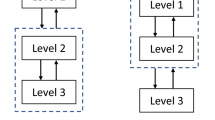Abstract
In practical designs, most of the multidisciplinary problems have a large-size and complicate design system. Since multidisciplinary problems have hundreds of analyses and thousands of variables, the grouping of analyses and the order of the analyses in the group affect the speed of the total design cycle. Therefore, it is very important to reorder and regroup the original design processes in order to minimize the total computational cost by decomposing large multidisciplinary problems into several multidisciplinary analysis subsystems (MDASS) and by processing them in parallel. In this study, a new decomposition method is proposed for parallel processing of multidisciplinary design optimization, such as collaborative optimization (CO) and individual discipline feasible (IDF) method. Numerical results for two example problems are presented to show the feasibility of the proposed method.
Similar content being viewed by others

References
Altus, S. S., Kroo, I. M. and Gage, P. J., 1995, “A Genetic Algorithm for Scheduling and Decomposition of Multidisciplinary Design Problems,”ASME paper 95-141.
Colville, A. R., “A Comparative Study on Nonlinear Programming Codes,” IBN New York Scientific Center Report No. 320-2949, June, Test Problem #8 (pg. 32), IBM Corporation, Philadelphia Scientific Center, Philadelphia, PA.
Eschenauer, H. A., Grauer, M., 1999, “Decomposition and Parallelization strategies for solving large-scale MDO problems,”Advances in Design Automation, Vol. 1, No. 1, pp. 24–43.
Kroo, I., Altus, S., Braun, R., Gage, P. and Sobieski, I., 1994, “Multidisciplinary Optimization Methods for Aircraft Preliminary Design,”AIAA 94-4325, 5th AIAA/USAF/NASA/ISSMO Symposium on Multidisciplinary Analysis and Optimization, pp. 697–707, Panama City, Florida, September 7–9
Kroo, I., Altus, S., Gage, P. and Sobieski, J., 1994, “Multidisciplinary Optimization Methods for Aircraft Preliminary Design,”AIAA-94-4325-CP, Proceedings of the 5 th AIAA/NASA/USAF/ISSMO Symposium on Multidisciplinary Analysis and Optimization, pp. 697–707, Panama City, Florida, September.
McCulley, C. M. and Bloebaum, C. L., 1994, “Optimal Sequencing for Complex Engineering Systems Using Genetic Algorithms,”Fifth AIAA/USAF/NASA/OAI Symposium on Multidisciplinary Analysis and Optimization, Panama City, FL.
Mitsuo, G., Runwei, C., 1997,Genetic Algorithms And Engineering Design, John Wiley & Sons Books, Inc., New York, pp. 1–40.
Rogers, J. L., 1989, “DeMAID-A Design Manager’s Aid for Intelligent Decomposition User’s Guide,”NASA TM-101575.
Rogers, J. L. and Barthelemy, J.-F.M., 1992, “Enhancements to the Design Manager’s Aid for Intelligent Decomposition (DeMAID),”AIAA paper No. 92-4809.
Rogers, J. L. and Bloebaum, C. L., 1994, “Ordering Design Tasks Based on Coupling Strength,”AIAA paper No. 94-4362.
Rogers, J. L., 1996, “DeMAID/GA an Enhanced Design Manager’s Aid for Intelligent Decomposition,”AIAA paper No. 96-4175, NASA Langley Research Center.
Sobieski, J., 1982, “A Linear Decomposition Method for Large Optimization Problems-Blueprint for Development,” NASA TM 83248.
Sobieski, J., 1988, “Optimization by Decomposition: a step from hierarchic to non-hierarchic systems,”Proc. Second NASA/ Air Force Symposium on Recent Advances in Multidisciplinary Analysis and Optimization, Hampton, VA, 28–30 September.
Sobieski, J., 1993, “Multidisciplinary Design Optimization An Emerging New Engineering Discipline,”World Congress on Optimal Design of Structural Systems, Brazil.
Sobieski, J., Agte, J. S., Sandusky, R., 1998, “Bi-Level Integrated System Synthesis (BLISS),” NASA/TM-1998-208715.
Stephen, M. B. and Marc, A. S., 1999, “Framework for Multidisciplinary Design Based on Response-Surface Approximations,”Journal of Aircraft, Vol. 36, No. 1, January–February, pp. 287–297.
Steward, D. V., 1981,Systems Analysis and Management, Structure Strategy and Design, Petrocelli Books, Inc., New York.
Tappeta, R., Nagendra, S., Renaud, J. E., Badhrinath, K., 1998,Concurrent Sub-Space Optimization (CSSO) MDO Algorithms in iSIGHT, GE Research & Development Center.
Vanderplaats, G. N., 1995,DOT Users Manual Version 4.20, Vanderplaats Research & Development, Inc.
Wagner, T. C., 1993,A General Decomposition Methodology for Optimal Systems Design, Doctoral Dissertation, Department of Mechanical Engineering and Applied Mechanics, University of Michigan, Ann Arbor.
Author information
Authors and Affiliations
Corresponding author
Rights and permissions
About this article
Cite this article
Park, HW., Kim, MS. & Choi, DH. A new decomposition method for parallel processing multi-level optimization. KSME International Journal 16, 609–618 (2002). https://doi.org/10.1007/BF03184810
Received:
Revised:
Issue Date:
DOI: https://doi.org/10.1007/BF03184810



